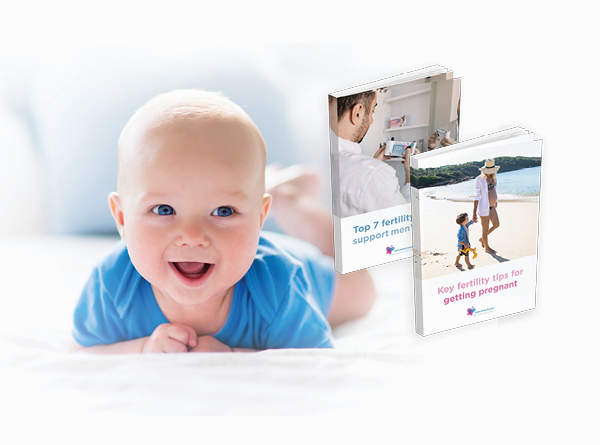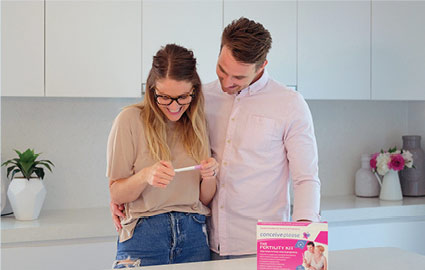If you are trying to conceive, knowing when you are ovulating is essential. With two fertile days a month and a 20% chance of successful conception, there is a precious small window of opportunity to fall pregnant, so knowing your ovulation cycle is important.
Understanding your ovulation cycle can be confusing and frustrating at times, so here is a guide to help you make the tracking process a little easier.
Know the key signs of ovulation
Apart from very common premenstrual cramping, there are two other key signs of ovulation to be aware of.
- Basal Body Temp rising
Your Basal Body Temperature changes throughout your cycle. Typically, you will see a temperature increase just after ovulation (that is, slightly higher than the normal body temp of 37ºC), that remains elevated until just prior to the initiation of your menses (period).
In order to increase your chances of becoming pregnant, you will want to identify and make use of every possible signal you can because you have only one chance each cycle in which to become pregnant. The variation of your temps during ovulation is very slight, so it is essential to take your temperatures very carefully, and preferably at the same time every day.
- Cervical mucus
Is an excellent physical sign that you can also for tracking ovulation. It’s something that you easily notice as it is something you do on a daily basis quite naturally. Cervical mucus changes in colour, clarity, and texture throughout your menstrual cycle.
As you approach the time of ovulation, your cervical mucus begins to thin, become more clear, and ‘stretchy’ - some women like to compare it to an egg-white consistency. This is not only a good indicator of ovulation, but it is actually essential for fertility. Your cervical mucus will nourish the sperm, protect them from the acid environment inside the vagina, and the long stretchy strands actually guide the sperm in the correct direction.
For most women, the days from the slippery wet mucus to menses is between 11 and 16 days. After charting for about two to three months, you can accurately predict your fertile days.
- Other possible signs that ovulation has occurred or is occurring:
- Mid-cycle ovulation pain called Mittelschmerz
- A heightened sense of smell and taste
- Increased libido
- Tender breasts
Detecting your LH Surge
During the ovulation phase, your pituitary gland will release a surge of LH (leutenizing hormone) and FSH (follicle stimulating hormone). This surge lasts for approximately 24 hours and is a signal your ovary to release the egg. By testing your urine for the presence of LH, you can accurately predict within 30 hours when you ovulate, with ovulation occurring approximately 28 to 32 hours after the beginning of the LH surge.
Our conceiveplease™ One Step LH Urine Ovulation Test removes any confusion and helps you predict when you are most fertile, maximising your chances of conceiving (yep, the optimum time to get busy!). One box of the conceivepleaseTM One Step LH Urine Ovulation Test contains five LH urine test sticks for your use in one menstrual cycle.
For most women who have a regular menstrual cycle, testing for five consecutive days should be more than sufficient to detect an LH surge. However, should you have an irregular cycle, or are unsure of the length of your cycle, you may need to test for longer and therefore may require additional ovulation tests to detect your LH surge.
Count the days
Some good old-fashion day counting is also important in tracking ovulation. First, work out the length of your average menstrual cycle. Day one is the first day of the menstrual period and the last day is the day before the next period begins. Your ovulation cycle begins about 14 days before the start of a period, so if you have a 28-day cycle, ovulation happens on day 14 and the ‘fertile window’ starts about day 11.
It is entirely normal for many women to experience cycles of varying lengths. If you have longer cycles, say 35 days between periods, ovulation happens on day 21 and the ‘fertile window’ starts on day 19. If you have very short cycles, say 21 days, ovulation happens on day 7 and your ‘fertile window’ would start on day 5. An easy way to estimate when you are most likely to get pregnant is to subtract 16 days from the average length of your menstrual cycle.
If you have very irregular/infrequent menstrual cycles then it will be difficult to know when you may be about to ovulate, that’s why it is so important to track your LH surge and look out for the other key signs of ovulation, too.
If all of the above seems a little overwhelming and stressful, don’t worry! Our 4-step Fertility Kit has all the tools you need for efficient and accurate ovulation tracking, to maximise your chances of a natural conception. To shop the Kit, click here.
Your pregnancy journey
Preparing for pregnancy
A good preconception plan to educate yourself about your fertility cycle and implementing recommended lifestyle changes optimises your chances of conceiving naturally.
Monitoring ovulation
In order to pinpoint your fertile window, you need to be aware of the length of your menstrual cycle. The average length of menstruation is 28 days.
During pregnancy
The female body will evolve dramatically within this time and there are many nutritional and lifestyle changes that will be necessary to meet the needs of a growing healthy foetus.
Download your FREE e-books for top fertility tips to help you get pregnant




